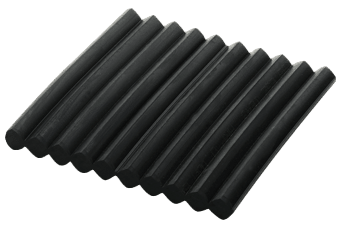ESZ Pyramid bearing
Static component support and impact noise protection
The ESZ Pyramid bearing is a profiled elastomeric bearing and is used for static and impact sound insulation of structural elements, in particular of reinforced concrete and prestressed concrete precast elements. It is used in accordance with the provisions of the building authority approval Z-16.32-195.
RFP texts

ESZ Type 200 - side view

Version including dummy formwork for in-situ concrete as stripe bearing
- The enivronmental influences must be checked with regard to possible damage to the bearings.
- Elastomer bearings and bearing surfaces must be free of contamination. Loose particles are not permissible.
- The bearing surfaces must be free of ice and snow, grease, solvents, oils or separating agents. This must be ensured by suitable measures.
- The bearing surfaces must be carefully deburred to protect the bearing.
- The alignment of the bearing surfaces must be checked. If necessary, the bearing surfaces must be brought into the planned condition by reworking.
- Individual surface imperfections must not exceed 100 mm2 and must not deviate more than 2.5 mm in depth from the surrounding surface. The total area of surface imperfection shall not exceed 10%.
- The bearing areas shall be designed in accordance with the design-specific technical specifications an standards. In general, edge distances should be proficed. The elastomeric bearing should be located within the reinforcement.
- If the bearings are used with steel contact surfaces, the steel surfaces should be at least 25 mm larger circumferentially than the bearing.
- If the elastomeric bearings are tamped underneath, special care should be taken to ensure good quality mortar. The elastomeric bearing must not be overloaded at any point. The load of structure to be supported by the bearings should not drectly load the bearing excluively via wedges, unless a sufficiently rigid steel plate is interposed to distribute the load. The wedges must be removed after the underpacking material has hardened.
- The lateral surfaces of the bearings must not be impeded in their planned deformation.
- Each component must be separated horizontally and vertically from the adjacent components by joints in such a way that the intended bearing (static) can become effective. It should be noted that deformabillity may be impaired by joint fillers, such as joint compounds, profiles made of foam or panels made of minderal wool or foam materials. In the case of in-situ concrete construction, the proper production of the bearing joint must be ensured.
- In the case of horizontally displaceable components, it must be checked whether fixed points or fixed zones must be arranged by which the zero point of movement of the component to be supported, is determined. It should be noted that unintentional fixed points can have a detrimental effect on component storage.
- The arrangement of several bearings on top of each other is not permissible.
Any questions regardingto our products?
Simply arrange an appointment with us. Our team will be happy to provide you with advice. By telephone or by email.


